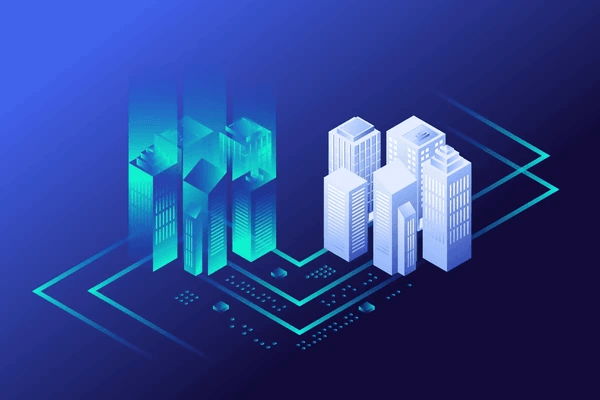12.07.2023
Digital Twins: Jargon or Secret Weapon?

Xavier Vargas

A recurring theme throughout my career has been that of helping people and companies understand ambiguous industry and technology terms: The Cloud, CRM, IoT, and now most recently, Digital Twin. If you’ve heard of a digital twin before, then thoughts may swirl in your head of 3D virtual environments, real-time visualizations of physical objects, and simulations of catastrophic “what if” scenarios that inch closer to accurate predictions of what WILL happen. A Minority Report future may not be so far away.
If you’re unfamiliar with the term, just think of a digital twin as a digital representation of a real-world thing or process. Having this digital representation allows you to visualize and manipulate things that would be cost prohibitive or too dangerous under real-world circumstances. This sci-fi concept can generate real world insights that enable businesses to scale and streamline operations.
Originating from the realm of industrial design and manufacturing, Digital Twins are gaining momentum as a game-changer for businesses of all sizes and across industries. Harnessing the power of Digital Twins opens new avenues for efficiency, productivity, and innovation, particularly for businesses that are willing to invest. While the possibilities unlocked by a digital twin may seem daunting at first glance, pragmatic application of technologies will lead to incremental advancement that allows an organization to reach the ideal level of maturity.
Understanding Digital Twins: A Spectrum of Maturity
As discussed, a Digital Twin is a digital representation of a physical object or system. However, the level of complexity and connectivity defines the spectrum within the Digital Twin concept.
- Digital Model: This represents the most basic form—a digital replica of a physical object. This might be something as simple as a 3D rendering, an analytics dashboard, or even a data model. Most importantly, it lacks connectivity and is (mostly) static, serving as a visual aid, reference, or foundational pillar.
- Digital Shadow: Moving up the spectrum, a Digital Shadow is a connected digital model synchronized with its physical counterpart. It provides real-time data which enhances operational visibility and enables more informed decision-making. This state of maturity allows organizations to gather historical telemetry data on which AI models can then be trained. One final thing to note: synchronization of the shadow is unidirectional and therefore the physical thing is not impacted by changes in the digital world.
- Digital Twin: At the pinnacle, a true Digital Twin offers bi-directional connectivity which in turn opens a realm of possibilities where a digital model can predict and make just-in-time modifications to a real world thing. The Digital Twin can even make these necessary adjustments in the real world with minimal human interaction and just the right amount of oversight. This level of sophistication empowers businesses to simulate scenarios, optimize processes, and predict or prevent outcomes.
The Scope of Modeling: Components, Assets, Processes, Systems
Digital Twins are not one-size-fits-all; they come in varying scopes, each catering to different facets of a business. Understanding this aperture is crucial for Businesses to tailor Digital Twins to their unique needs:
- Component: At the granular level, Digital Twins can represent individual components. For manufacturing businesses, this could be a vital piece of a more complex machine or a specific part of their production line.
- Asset: Scaling up, Digital Twins can model entire assets—machinery, vehicles, or infrastructure. This level of representation enhances maintenance, monitoring, and optimization efforts.
- Process: For those engaged in complex processes, Digital Twins can simulate and optimize workflows. This is invaluable for industries such as logistics, where efficiency is paramount.
- System: Businesses often operate as interconnected systems. Digital Twins can replicate these systems, providing a holistic view and enabling comprehensive optimization.
Applications for Businesses of All Sizes
The specific use cases are endless and should be used as the starting point to define what it is that your organization wants to get out of implementing a Digital Twin:
- Operational Efficiency: Digital Twins empower businesses to optimize operations by providing real-time insights into equipment performance, enabling predictive maintenance, and reducing downtime.
- Product Development: For businesses involved in product creation, a Digital Twin can streamline the product development lifecycle. From prototyping to production, the digital representation facilitates collaboration and iteration.
- Supply Chain Management: Visualizing and optimizing the supply chain is critical for organizations of all sizes. Digital Twins can enhance visibility, predict disruptions, and improve overall supply chain resilience.
- Sustainability: For businesses conscious of their environmental footprint, Digital Twins offer tools to monitor and optimize energy consumption, contributing to sustainability goals.
- Risk Mitigation: Digital Twins enable businesses to simulate and assess risks in various scenarios, allowing for proactive risk management and strategic decision-making.
- Customization and Innovation: organizations can leverage Digital Twins to customize products or services, tailoring offerings to meet specific customer needs. This fosters innovation and enhances customer satisfaction.
Overcoming Challenges and Embracing the Future
While the benefits are substantial, organizations must navigate challenges such as initial implementation costs, data security concerns, and the need for skilled personnel. Collaborating with technology partners like North Highland, investing in training, and adopting scalable solutions can mitigate these challenges.
In the digital era, harnessing the potential of Digital Twins is not a luxury but a strategic imperative for organizations looking to adapt, innovate, and out-pace their peers. From improving day-to-day operations to fostering innovation, the spectrum of Digital Twins offers a transformative journey towards growth and resilience. As small and medium-sized businesses continue to embrace digitalization, the era of the Digital Twin becomes not just a technological trend but a key driver of sustainable success.


